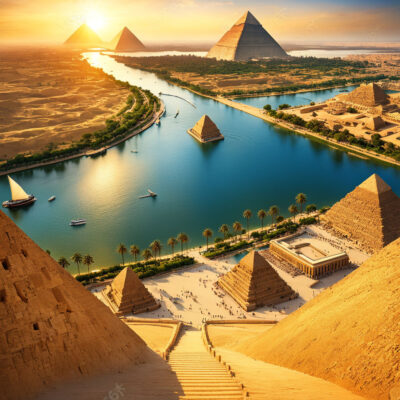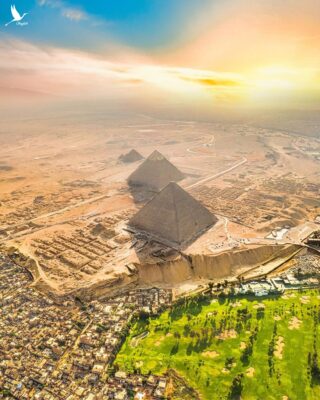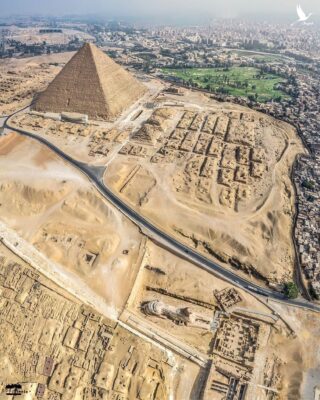The Nile River, flowing majestically through Egypt, has played a crucial role in shaping the civilization that built one of the Seven Wonders of the Ancient World—the Pyramids of Giza. These towering structures, often depicted with the mighty Nile at their feet, symbolize the profound relationship between the river and the land. The Nile’s life-giving waters, combined with the ingenuity of the ancient Egyptians, helped create a civilization that continues to captivate the world.
Follow archeology.dulichvn.net to learn more about mysterious artifacts.

The Nile’s Role in the Rise of Ancient Egypt
The Life-Giving Source of the Nile
The Nile River was the cornerstone of ancient Egyptian civilization, providing the lifeblood for society. Each year, the river’s annual flooding deposited rich, dark silt over the surrounding land, transforming the otherwise arid desert into a lush, fertile plain ideal for agriculture. This cycle, predictable and dependable, formed the foundation for Egypt’s economy, allowing the ancient Egyptians to cultivate abundant crops, support a growing population, and build impressive infrastructure, including monumental structures like the pyramids. The river not only sustained the agricultural production necessary for survival but also shaped the very landscape and way of life for the ancient Egyptians.
A Vital Transportation Route for Trade and Communication
The Nile River was not only crucial for agriculture but also served as Egypt’s primary transportation route. Boats navigated the river’s currents, connecting different parts of the kingdom and facilitating trade with neighboring regions. Goods such as precious metals, timber, and exotic items flowed through Egypt, enriching the economy and enabling the rise of one of the wealthiest civilizations in history.
The river’s role as a natural highway fostered the exchange of ideas, cultures, and technologies, which were key to the advancement of Egyptian society. The Nile, thus, acted as a unifying force, linking people across vast distances, from the southern reaches of Nubia to the Mediterranean coastline, and ensuring the integration of Egypt as a powerful cultural and economic hub.
A Sacred and Divine River
To the ancient Egyptians, the Nile was more than just a practical resource—it was a sacred, divine presence. The river was believed to be the earthly manifestation of Hapi, the god of fertility and abundance, who was revered for bringing prosperity to the land. Each year, the predictable flooding of the Nile was seen as a sign of divine favor, symbolizing the order of the cosmos and the gods’ blessing upon Egypt. The Egyptians’ understanding of the Nile’s cycles deeply influenced their religious practices and worldview.
The river’s annual inundation not only ensured the fertility of the land but was also thought to maintain harmony and balance, vital for the survival of the civilization. As such, the Nile held a central place in Egyptian myth, culture, and spirituality, with rituals and prayers dedicated to it, affirming its sacred status.

The Pyramids: An Enduring Symbol of Ancient Egypt
The Giza Pyramids: Marvels of Ancient Engineering
The Pyramids of Giza stand as awe-inspiring symbols of ancient Egyptian architectural genius and engineering prowess. Built during the Fourth Dynasty of the Old Kingdom, these monumental structures served as elaborate tombs for the pharaohs, intended to protect their bodies, treasures, and souls in the afterlife.
The precision with which these pyramids were constructed reveals an extraordinary understanding of mathematics, geometry, and astronomy. The alignment of the pyramids, especially the Great Pyramid, with cardinal points and celestial bodies is a clear indication of the advanced scientific knowledge that the ancient Egyptians possessed. These timeless structures continue to fascinate researchers and visitors alike, embodying the pinnacle of ancient engineering.
The Nile’s Role in the Construction of the Pyramids
The construction of the pyramids would have been an impossible feat without the life-giving Nile River. The river was central to the transportation of the massive limestone and granite blocks required for the pyramids. Quarried from distant locations, these blocks were transported via boat along the Nile, utilizing its waters to move the heavy materials efficiently.
The river not only provided a means of transportation but also offered water to sustain the large workforce of laborers, craftsmen, and engineers who toiled tirelessly under the scorching desert sun. The Nile, thus, was not only a natural resource for agriculture but also an indispensable lifeline in the creation of one of the world’s greatest architectural achievements.
A Sacred Connection Between the Divine and the Mortal
The pyramids of Giza were designed to serve a far greater purpose than merely housing the remains of pharaohs. They were built as spiritual gateways, meant to link the pharaohs with the divine and facilitate their journey to the afterlife. The positioning of the pyramids near the Nile reinforced the belief that the river played a crucial role in this sacred transition, guiding the pharaoh’s soul to immortality.
This connection between the divine and the mortal realm was central to the Egyptian view of the afterlife, where the pharaohs were not only kings but also divine beings. The union of the sacred pyramids with the Nile’s life-giving waters created a powerful spiritual landscape, symbolizing the eternal bond between the earth and the heavens.

The Nile and Pyramids in Modern Times
A Major Tourist Attraction: The Pyramids of Giza
The Pyramids of Giza remain one of the world’s most iconic and sought-after tourist destinations, attracting millions of visitors annually. These awe-inspiring structures, with their towering presence and intricate history, continue to captivate the imaginations of people from all corners of the globe.
The sheer scale and craftsmanship of the pyramids are a testament to the ancient Egyptians’ advanced engineering abilities. As visitors marvel at the pyramids’ architecture, they are also drawn to the surrounding mysteries that have intrigued scholars for centuries. The Nile, flowing gracefully nearby, enhances the beauty and historical significance of these monuments. Tourists can embark on boat rides along the Nile, offering a rare opportunity to experience the vital role this river played in the ancient Egyptian civilization and its connection to the pyramids.
Preserving the Sacred Connection: The Nile and the Pyramids
Maintaining the sacred relationship between the Nile River and the pyramids is vital for preserving Egypt’s rich cultural heritage. The ancient bond between these monumental structures and the life-giving river is an integral part of Egypt’s history, and efforts to protect both the river and its surrounding landmarks are critical to safeguarding this unique cultural treasure. In recent years, there have been growing initiatives aimed at preserving these ancient wonders while promoting sustainable tourism.
Conservation projects and awareness campaigns are designed to ensure that future generations can continue to experience the powerful connection between the Nile and the pyramids, without compromising the integrity of these sites. By focusing on eco-friendly practices and responsible tourism, Egypt aims to protect this legacy for years to come.
The Ongoing Mystery of the Pyramids: Unveiling the Secrets of the Past
Despite centuries of research, the Pyramids of Giza continue to hold an air of mystery, with many aspects of their construction and purpose still shrouded in uncertainty. While ancient texts and records have provided valuable clues, modern archaeological methods and technology are now offering new insights into these enduring wonders. Innovations such as satellite imaging, ground-penetrating radar, and 3D modeling are allowing researchers to explore the pyramids in unprecedented detail.
These tools are helping to uncover hidden chambers, improve our understanding of the construction methods used, and even shed light on the spiritual and astronomical significance of the pyramids. As technology advances and new research unfolds, we can expect to learn even more about the profound connection between the Nile River and these ancient structures, deepening our appreciation for the remarkable civilization that built them.
See more: The Walls of Constantinople in the 1950s: A Historical Perspective
Conclusion
The Nile River’s embrace of the pyramids symbolizes the profound and lasting impact the river had on ancient Egypt. From providing the resources needed for agriculture and construction to inspiring religious beliefs and cultural practices, the Nile was essential in shaping one of the world’s greatest ancient civilizations. Today, the pyramids stand as enduring symbols of the harmony between nature and human ingenuity, forever intertwined with the life-giving waters of the Nile.


CÁC TIN KHÁC
Mary Walton: The Forgotten Inventor Who Helped Clean Up America’s Cities
Tomb of Queen Nefertari in the Valley of the Queens, Egypt
Discover the Hypostyle Hall of the Temple of Hathor at Dendera
Venus de Losange: Unveiling the Mystery of a 20,000-Year-Old Paleolithic Icon